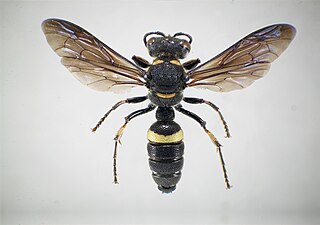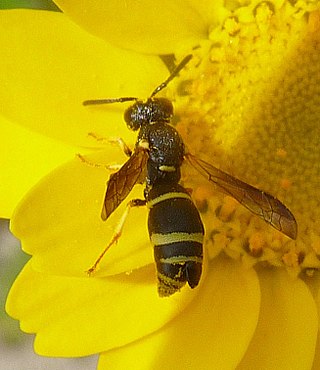
The ovipositor is a tube-like organ used by some animals, especially insects, for the laying of eggs. In insects, an ovipositor consists of a maximum of three pairs of appendages. The details and morphology of the ovipositor vary, but typically its form is adapted to functions such as preparing a place for the egg, transmitting the egg, and then placing it properly. For most insects, the organ is used merely to attach the egg to some surface, but for many parasitic species, it is a piercing organ as well.

Apocrita is a suborder of insects in the order Hymenoptera. It includes wasps, bees, and ants, and consists of many families. It contains the most advanced hymenopterans and is distinguished from Symphyta by the narrow "waist" (petiole) formed between the first two segments of the actual abdomen; the first abdominal segment is fused to the thorax, and is called the propodeum. Therefore, it is general practice, when discussing the body of an apocritan in a technical sense, to refer to the mesosoma and metasoma rather than the "thorax" and "abdomen", respectively. The evolution of a constricted waist was an important adaption for the parasitoid lifestyle of the ancestral apocritan, allowing more maneuverability of the female's ovipositor. The ovipositor either extends freely or is retracted, and may be developed into a stinger for both defense and paralyzing prey. Larvae are legless and blind, and either feed inside a host or in a nest cell provisioned by their mothers.

Wasps in the family Pompilidae are commonly called spider wasps, spider-hunting wasps, or pompilid wasps. The family is cosmopolitan, with some 5,000 species in six subfamilies. Nearly all species are solitary, and most capture and paralyze prey, though members of the subfamily Ceropalinae are kleptoparasites of other pompilids, or ectoparasitoids of living spiders.

Parasitoid wasps are a large group of hymenopteran superfamilies, with all but the wood wasps (Orussoidea) being in the wasp-waisted Apocrita. As parasitoids, they lay their eggs on or in the bodies of other arthropods, sooner or later causing the death of these hosts. Different species specialise in hosts from different insect orders, most often Lepidoptera, though some select beetles, flies, or bugs; the spider wasps (Pompilidae) exclusively attack spiders.

Commonly known as cuckoo wasps or emerald wasps, the hymenopteran family Chrysididae is a very large cosmopolitan group of parasitoid or kleptoparasitic wasps, often highly sculptured, with brilliant metallic colors created by structural coloration. They are most diverse in desert regions of the world, as they are typically associated with solitary bee and wasp species, which are also most diverse in such areas. Their brood parasitic lifestyle has led to the evolution of fascinating adaptations, including chemical mimicry of host odors by some species.

The subfamily Chrysidinae contains those species that are most commonly recognized as cuckoo wasps, being by far the largest and most familiar subfamily. The group contains 3000 species with 48 genera worldwide. They are highly sculptured, with brilliantly metallic-colored bodies, covering the entire spectrum, but primarily blues and greens.

A wasp is any insect of the narrow-waisted suborder Apocrita of the order Hymenoptera which is neither a bee nor an ant; this excludes the broad-waisted sawflies (Symphyta), which look somewhat like wasps, but are in a separate suborder. The wasps do not constitute a clade, a complete natural group with a single ancestor, as bees and ants are deeply nested within the wasps, having evolved from wasp ancestors. Wasps that are members of the clade Aculeata can sting their prey.

Cerceris fumipennis, the only species of buprestid-hunting Crabronidae occurring in eastern North America, is found throughout the continental United States east of the Rockies: from Texas and Florida north to Maine, Wyoming, and into Canada. The wasps most often nest in open areas of hard-packed sandy soil surrounded by woody habitat suitable for their buprestid beetle prey.

Chrysis ignita is a species of cuckoo wasp. It is one of a group of species which are difficult to separate and which may be referred to as ruby-tailed wasps. Cuckoo wasps are kleptoparasites – they lay their eggs in the nests of other species and their young consume the eggs or larva of the host for sustenance. These wasps have a number of adaptations which have evolved to equip them for their life cycle. Chrysis ignita parasitize mason bees in particular. Ruby-tailed wasps have metallic, armored bodies, and can roll up into balls to protect themselves from harm when infiltrating the nests of host bees and wasps. Unlike most other aculeates, cuckoo wasps cannot sting. Chrysis ignita is found across the European continent.

Chrysis viridula is a Western Palearctic species of cuckoo wasp, first described by Carl Linnaeus in 1761. Chrysis viridula is included in the genus Chrysis, and the family Chrysididae. It is a parasitoid of a number of species of eumenid wasp, mainly those in the genus Odynerus.

Odynerus spinipes, the spiny mason wasp, is a species of potter wasp from western Europe. It is the type species of the genus Odynerus, being first described by Carl Linnaeus in his landmark 1758 10th edition of Systema Naturae.
Stigmus americanus is a species of aphid wasp in the family Crabronidae. It is found in North America.

Chrysura simplex is a species of cuckoo wasps, insects in the family Chrysididae.

Trichrysis cyanea is a species of cuckoo wasps, insects in the family Chrysididae.

Chrysis angustula is a species of cuckoo wasps, insects in the family Chrysididae.

Lysiphlebus testaceipes is a species of small braconid parasitoid wasp in the subfamily Aphidiinae. L. testaceipes can utilize numerous species of aphids as hosts and has often been used as a biological control agent against aphid pests. It is considered an invasive species in several European countries.

Omalus is a genus of cuckoo wasps in the family Chrysididae.

Omalus aeneus is a species of cuckoo wasps belonging to the family Chrysididae.

Chrysura hirsuta, also known as the Northern Osmia ruby-tailed wasp, is a species of parasitic cuckoo wasp within the family Chrysididae.
Chrysura austriaca, also known as the Austrian cuckoo wasp, is a species of parasitic wasp within the family Chrysididae.


















